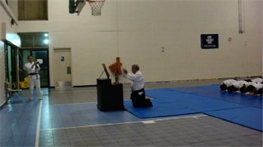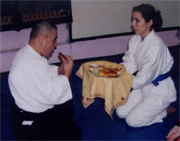Aikido Kobayashi Dojo
from the Dojocho's Blog
from the Dojocho's Blog
Dojo Customs
At Aikido Kobayashi Dojo, we begin training only by bowing to shomen (front side), and then bowing to each other. As custom, when we bow to shomen, it used to mean bowing to the altar, the hanging scroll of “aikido”, and the photograph of O-sensei, the founder of aikido. However, we do not put an alter to new dojos we open these days, because we now have people with many different religions and cultures coming to practice. We only put an O-sensei photo, calligraphy, and a hanging scroll written by myself.
Many dojos throughout the world have the similar style: a photo of O-sensei and calligraphy. When bowing, the hands are clapped or there may be chanting. I don’t see too many dojos that give a reading from an Aikido teaching, but I’ve had all kinds of experiences with different customs in dojos world-wide.

First, the dojo in Hawaii. Hawaii has many people of Japanese descent. Because Japan lost at the WWII, the third and fourth generations lost their confidence in Japanese culture. By seeing this, the first and second generations felt necessity in inheriting the spiritual aspects of Japanese culture to them, and have incorporated some of these aspects into Aikido practice. Hawaii was the earliest to receive Aikido in the U.S., starting in 1953. That renewed tradition is still alive today among them.
The dojo is in a gymnasium but at the front is a replica altar with a photograph of O-sensei and a scroll of his calligraphy as well as a ceremonial mirror wrapped on a purple fukusa (traditional Japanese wrapping cloth). Before practice everyone sits in seiza facing the front and the person in charge ceremoniously unveils the mirror and places it on the altar - then practice begins. At the end of practice, he or she replaces the mirror in the fukusa and rewraps it. The atmosphere is solemn and respectful.
My most memorable ceremony was in a Dojo in Bulgaria. Before practice everyone was lined up sitting in seiza. I was sitting in the front in seiza when suddenly a woman carrying a big round flat baked bread on a tray sat in front of me and offered up the bread. No one had told me about this so I didn’t know what the proper thing to do was. There was salt on the side and I figured that this was a traditional ceremony but the bread was way too big for me to eat in one sitting.

I took a small bit of salt and put that on the bread and tore a piece off to eat. She lowered the tray and returned to the back. That turned out to be the right thing to do but it was the first experience for me with this kind of ceremony. Later I asked about the meaning of the ceremony but because of the language difficulties no-one was able to explain. When I was back in Japan, I happened to be watching a TV program about ethnic Russians and saw a similar ceremony. In the past, in the cold winter where everyone was poor it was the custom to offer guests salt and bread to welcome them. I finally understood.
At that time when I was an uchideshi and stayed close to O-sensei, I experienced various Shinto rituals practiced by him. In Shinto tradition, salt is used to purify our places and spirits. That experience gave me a hint in Bulgaria. So, I think that we should have as many experiences as possible and learn as much as possible from these experiences.
Nov. 15, 2006
Apr. 2, 2008
Nov. 10, 2008
Dec. 30, 2009
Apr. 22, 2010
May. 11, 2010
Aikido Kobayashi Dojo Beijing, Zheng Xin Guan Seminar, Part 1
Apr. 17, 2013
Sep. 8, 2013
Nov. 25, 2013
Nov. 20, 2014
Apr. 20, 2015
May. 3, 2015
Jun. 24, 2015
Jul. 2, 2015
Nov. 2, 2015
Apr. 6, 2016
It all started from one call...... (by Hiroaki Kobayashi dojocho)
Mar. 29, 2017
Apr. 10, 2017
With my grandfather to Nordic countries on an Aikido tour (by Kaho Kobayashi)